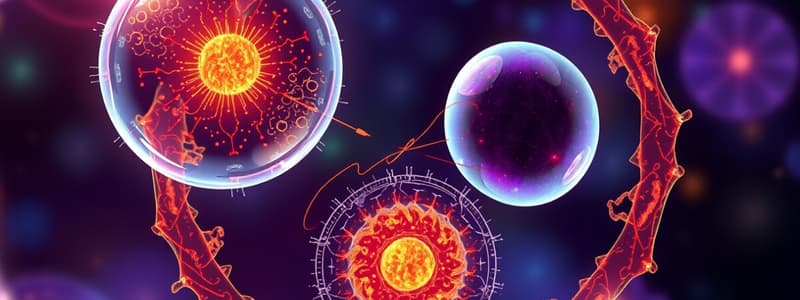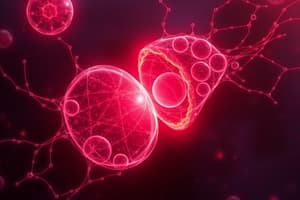Podcast
Questions and Answers
What is meiosis?
What is meiosis?
- Is the process of mitosis.
- Creates 2 diploid cells from a diploid cell.
- Creates 4 haploid gamete cells from a diploid cell. (correct)
- Involves nuclear membrane dissolution.
What happens during interphase in meiosis?
What happens during interphase in meiosis?
The DNA is in its chromatin form and the DNA replicates.
Describe prophase I in meiosis.
Describe prophase I in meiosis.
The DNA coils into visible chromosomes, sister chromatids are connected by a centromere, and crossing over occurs.
What does crossing over involve?
What does crossing over involve?
What are homologous chromosomes?
What are homologous chromosomes?
What occurs during metaphase I?
What occurs during metaphase I?
What happens during anaphase I?
What happens during anaphase I?
What is the outcome of telophase I?
What is the outcome of telophase I?
What process occurs during cytokinesis?
What process occurs during cytokinesis?
What happens during prophase II?
What happens during prophase II?
Describe metaphase II.
Describe metaphase II.
What occurs during anaphase II?
What occurs during anaphase II?
What is the result of telophase II?
What is the result of telophase II?
Define chromatin.
Define chromatin.
Flashcards are hidden until you start studying
Study Notes
Meiosis Overview
- Meiosis produces four haploid gametes from one diploid cell, essential for sexual reproduction.
Interphase (Stage 1)
- DNA exists in chromatin form and undergoes replication, preparing for the meiotic process.
Prophase I (Stage 2)
- DNA coils into visible chromosomes; sister chromatids are linked by a centromere.
- Nuclear membrane begins to dissolve; centrosomes move to poles and spindle fibers form.
- Crossing over occurs, allowing genetic material exchange between homologous chromosomes.
Crossing Over
- A process where homologous chromosomes pair up and exchange genetic information, enhancing genetic diversity.
Homologous Chromosomes
- Chromosomes from each parent that match in size and shape, contributing to genetic variation.
Metaphase I (Stage 3)
- Fully formed spindle fibers attach to centromeres of homologous chromosomes.
- Chromosomes align at the cell's equatorial plane alongside their homologous partners.
Anaphase I (Stage 4)
- Spindle fibers pull homologous chromosomes toward opposite poles, leading to chromosome separation.
Telophase I (Stage 5)
- Chromosomes reach poles and nuclear membranes reform around each set, initiating de-coiling into chromatin.
- Cytokinesis divides the cell, resulting in two diploid cells, which will undergo further division.
Cytokinesis
- Division of the cytoplasm occurs during Telophase I and II, concluding each meiotic division phase.
Prophase II (Stage 6)
- No interphase occurs between Meiosis I and II; chromosomes reorganize and nuclear membranes dissolve.
- Sister chromatids are again connected by centromeres as spindles reform.
Metaphase II (Stage 7)
- Spindle fibers attach to centromeres of the chromosomes, which realign in a single row along the spindle's equator.
Anaphase II (Stage 8)
- Spindle fibers pull sister chromatids apart, moving each to opposite poles of the cell.
Telophase II (Stage 9)
- Nuclear membranes form around each chromosome set; cleavage furrows develop.
- Resulting in four haploid cells: in males, four functional sperm; in females, one viable egg and three polar bodies, which are generally non-functional.
Chromatin
- Thread-like structures containing genetic information, visible only during Interphase, crucial for genetic material organization and replication.
Studying That Suits You
Use AI to generate personalized quizzes and flashcards to suit your learning preferences.




